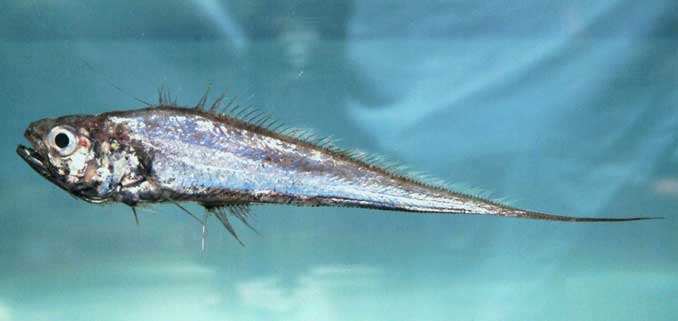
Steindachneria argentea (SEFSC Pascagoula Laboratory; Collection of Brandi Noble, NOAA/NMFS/SEFSC )
Superregnum: Eukaryota
Cladus: Unikonta
Cladus: Opisthokonta
Cladus: Holozoa
Regnum: Animalia
Subregnum: Eumetazoa
Cladus: Bilateria
Cladus: Nephrozoa
Superphylum: Deuterostomia
Phylum: Chordata
Subphylum: Vertebrata
Infraphylum: Gnathostomata
Megaclassis: Osteichthyes
Superclassis/Classis: Actinopterygii
Classis/Subclassis: Actinopteri
Subclassis/Infraclassis: Neopterygii
Infraclassis: Teleostei
Megacohors: Osteoglossocephalai
Supercohors: Clupeocephala
Cohors: Euteleosteomorpha
Subcohors: Neoteleostei
Infracohors: Eurypterygia
Sectio: Ctenosquamata
Subsectio: Acanthomorphata
Divisio/Superordo: Paracanthopterygii
Series: Zeiogadaria
Subseries: Gadariae
Ordo: Gadiformes
Familia: Merlucciidae
Genus: Steindachneria
Species: Steindachneria argentea
Name
Steindachneria argentea Goode & Bean, 1896
Holotype: USNM 37350
References
Goode, G. B. & T. H. Bean, 1896. Oceanic ichthyology, a treatise on the deep-sea and pelagic fishes of the world, based chiefly upon the collections made by the steamers Blake, Albatross, and Fish Hawk in the northwestern Atlantic, with an atlas containing 417 figures. Special Bulletin U. S. National Museum No. 2: Text: i-xxxv + 1-26 + 1-553, Atlas: i-xxiii, 1-26, 123 pls.
Steindachneria argentea – Taxon details on Integrated Taxonomic Information System (ITIS).
The luminous hake (Steindachneria argentea) is a West Atlantic member of the Merluccidae family.[1] It is the only member of its genus.[2]
Characteristics
Luminous hake grow to a maximum of 30 cm (12 in) in total length. They have a silver colored body with slight brown coloring in dorsal areas, a purple tint ventrally, and a dark oral cavity. They have big eyes on a large head and a tapering body that ends in a point since they have no caudal fin.[1] Their luminosity comes from a characteristic striated light organ on the sides of the head and lower (ventral) half of the body. The anus is found between the pelvic fins and is widely separated from the urogenital opening located anterior to the anal fin.[3]
Luminous hake have uninterrupted lateral lines.[1] They have a combined total of 18-20 gill rakers with five on the upper limb and 13-15 on the lower limb. The front of the first of two dorsal fins is the location of its one spine. The one anal fin is made up of a total of 123-125 soft rays. They possess paired pectoral and pelvic fins. The pectoral fins have 14-17 soft rays. The pelvic fins are located in the thoracic region.[1][3]
Distribution
Luminous hake are common in deep water but can be found on the outer shelf and on soft muddy bottoms of the Western Atlantic, Florida, northern Gulf of Mexico through Central America to Venezuela.[1][3] The luminous hake occur at a depth range of 400–500 meters.[1]
Other information
This species is of no interest by fisheries.[1]
Merluccius albidus is a predator of luminous hake.[1]
References
Froese, Rainer; Pauly, Daniel (eds.) (2015). "Steindachneria argentea" in FishBase. August 2015 version.
Froese, Rainer and Pauly, Daniel, eds. (2015). Species of Steindachneria in FishBase. August 2015 version.
Hoese, H. Dickson and Moore, Richard. (1998). “Fishes of the Gulf of Mexico: Texas, Louisiana, and Adjacent Waters”
Retrieved from "http://en.wikipedia.org/"
All text is available under the terms of the GNU Free Documentation License

